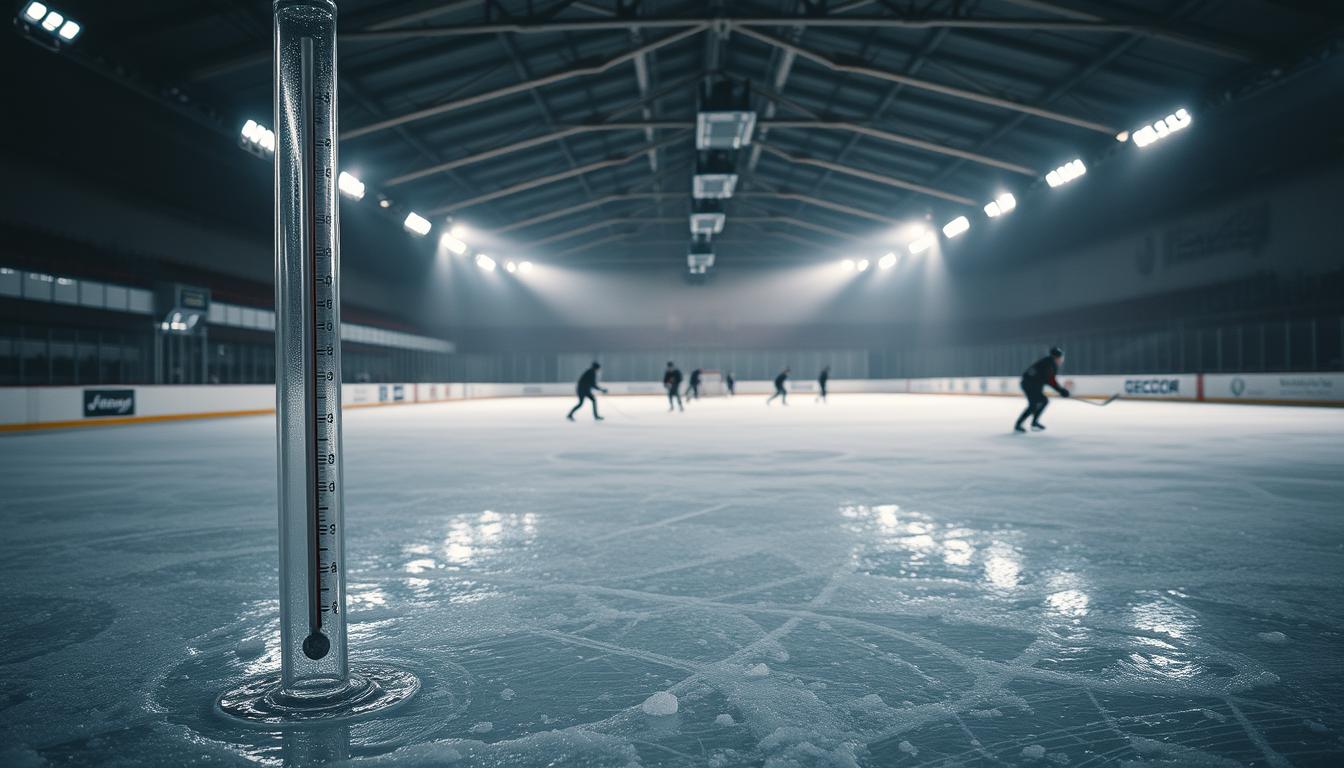How Cold Are Ice Skating Rinks? Find Out Now (Temperature Secrets Revealed)
Imagine stepping onto a glistening ice surface. Here, temperatures are key to your skating experience. Knowing how cold ice skating rinks are is vital for every skater.
Ice skating rinks are special environments. They turn water into a smooth, precise surface. Facilities keep the temperature just right for performance, safety, and comfort.
Skaters of all levels rely on these controlled temperatures. Rinks usually keep the temperature between 24-26 degrees Fahrenheit. This creates the best skating environment for fun and competition.
Different skating activities need different temperatures. Figure skating and hockey, for example, require slight temperature changes. This ensures top performance and safety.
Knowing about ice skating rink temperatures is more than just trivia. It’s about making your skating experience perfect. Every degree counts when you’re gliding on a surface made for performance and fun.
Temperature control is the hidden science behind skating. It’s what makes skating possible, from Olympic training to local rinks. Whether you’re new or experienced, the temperature of your skating surface is key.
In this guide, we’ll dive into the world of ice rink thermal management. You’ll see how science, technology, and precision turn water into a magical skating surface.
Understanding Ice Rink Temperature Basics
Ice skating is more than just moving on ice. It’s a mix of physics, temperature control, and engineering. The right ice skating temperature is key for a great skating experience.
Creating top-notch ice surfaces needs a deep grasp of physics and temperature control. Keeping the ice rink temperature right is a complex task. It involves many important factors.
The Science Behind Ice Formation
Water turns into ice under certain conditions. Here’s what happens at the molecular level:
- Water molecules slow down and form a crystalline structure
- Freezing happens at 32°F (0°C)
- Keeping the temperature just right prevents uneven freezing
Why Temperature Control Matters
Managing temperature greatly affects skating quality. Small changes can lead to:
- Soft, mushy ice that slows skaters
- Hard, brittle surfaces that increase injury risks
- Uneven skating conditions
Basic Temperature Requirements
Professional rinks keep temperatures in a specific range for the best skating. The ideal temperature for most activities is between 24°F and 28°F (-4°C to -2°C).
Knowing these temperature details helps skaters see the hard work behind a perfect ice surface.
The Ideal Temperature Range for Ice Skating Rinks
Skating fans know the right ice rink temperature is key. It can turn a good skate into an amazing one. Knowing the best temperature is essential for great skating.
The ideal temperature for ice rinks is between 24°F and 26°F (-4°C to -3°C). This range keeps the ice solid but not too hard. It’s perfect for skaters of all levels.
- Professional hockey rinks: Maintained at 22°F to 24°F
- Figure skating surfaces: Slightly warmer, around 24°F to 26°F
- Public skating rinks: Usually kept at 25°F to 26°F
Several things affect the best ice rink temperature. These include:
- Humidity levels
- Air temperature
- Number of skaters
- Type of skating activity
Rink managers keep a close eye on the temperature. They adjust it to keep the ice perfect. They aim for a surface that’s smooth but not too hard.
Changes in temperature can really affect the ice. If it’s too warm, the ice is soft and slow. If it’s too cold, it’s hard and might crack.
How Cold Are Ice Skating Rinks: A Detailed Analysis
Skating fans often ask about the exact temperatures needed for perfect ice. It’s not just about reading a thermometer. The science behind ice rink temperatures mixes physics, engineering, and careful temperature control.
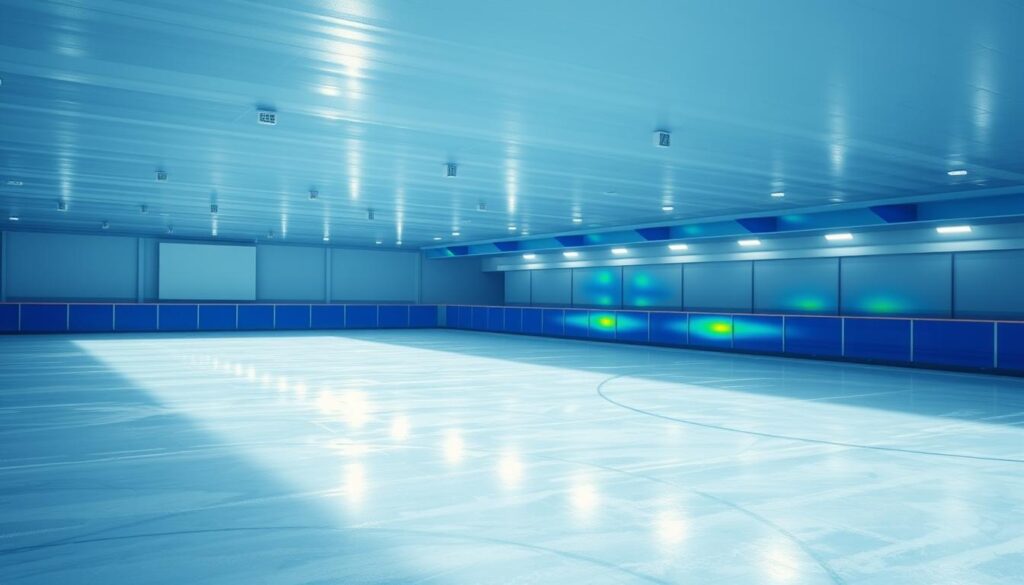
Keeping ice rink temperatures just right is key for great skating and safety. Professional rinks aim for specific temperature ranges that might surprise many.
Surface Temperature vs. Air Temperature
The ice surface temperature is quite different from the air above it. Ice skating rink temperatures usually fall between:
- Surface ice temperature: 22°F to 24°F (-5.5°C to -4°C)
- Air temperature above the ice: 50°F to 55°F (10°C to 13°C)
Temperature Variations by Zone
| Rink Zone | Typical Temperature | Performance Impact |
|---|---|---|
| Center Ice | 22-23°F | Most consistent skating surface |
| Rink Corners | 23-24°F | Slightly softer ice conditions |
| Edges | 24-25°F | More friction, possible performance change |
Impact on Ice Quality
Changes in temperature affect the ice quality. Precise temperature control leads to:
- A consistent skating surface
- Best blade glide
- Less chance of ice damage
- A better skating experience
Skaters can notice small changes in ice conditions. These changes come from tiny temperature differences across the rink.
Indoor vs. Outdoor Ice Rink Temperature Management
Skating fans know that temperature control is key. Indoor and outdoor ice rinks face different challenges to keep the ice perfect.
Indoor ice rinks need advanced tech to manage temperature. Managers must balance many factors for the best skating:
- Precise refrigeration systems
- Humidity regulation
- Crowd heat management
- Consistent temperature tracking
Outdoor ice rinks need even more planning. Natural elements like sunlight and wind make it tough for rink operators.
Indoor and outdoor rinks differ in a few ways:
- Temperature Stability: Indoor rinks stay at 24-28°F. Outdoor rinks change a lot.
- Environmental Controls: Indoor places use advanced cooling.
- Weather Impact: Outdoor rinks deal with sunlight, wind, and temperature changes.
Rink managers use the latest tech to solve these problems. They use thermal sensors and climate control systems. This way, skaters get the best ice, no matter where they are.
For both skaters and rink managers, knowing about temperature control is important. Whether you’re skating indoors or outdoors, the right temperature makes a big difference.
Professional Ice Rink Cooling Systems
Ice skating rinks need advanced cooling tech that works all day. They use complex systems to keep the ice perfect. This shows the science behind keeping ice rink temperature just right.
Advanced Refrigeration Equipment
Modern ice rinks have special cooling systems for the best skating. These systems include:
- Industrial-grade compressors
- Glycol cooling networks
- Precision temperature control units
- Embedded piping beneath the ice surface
Temperature Monitoring Technology
Modern sensors and digital systems are key for ice rink temperature control. Rink managers can see temperature changes live. This helps keep the ice quality steady.
| Monitoring Technology | Precision Level | Response Time |
|---|---|---|
| Digital Temperature Sensors | ±0.1°F | Instant |
| Infrared Surface Scanners | ±0.2°F | 2-3 seconds |
| Automated Cooling Management | ±0.5°F | 5-10 seconds |
Emergency Cooling Procedures
Professional rinks have strict emergency plans to stop ice damage. Rapid response cooling systems quickly fix temperature issues. This is for sudden heat changes or system failures.
- Backup refrigeration units
- Redundant cooling circuits
- Automatic temperature adjustment mechanisms
- Rapid intervention cooling protocols
These advanced systems make sure skaters have great ice all the time. The tech keeps getting better, making skating safer and more fun.
Factors Affecting Ice Rink Temperature Stability
Keeping the ice rink at the right temperature is a big challenge. It needs careful management of many environmental factors. Successful rink operators know that the perfect temperature for ice skating is a balance of many things.
Several key factors directly impact the stability of ice rink temperatures:
- Skater Density: Each person generates approximately 100 watts of body heat
- Humidity Levels: Moisture content in the air affects ice surface quality
- Building Insulation: Structural integrity plays a critical role in temperature management
- Air Circulation Systems: Proper ventilation helps maintain consistent temperatures
Keeping the ice rink temperature right is more than just checking the thermometer. External environmental conditions make it hard for rink managers. They must always adjust to new situations.
| Temperature Factor | Impact on Ice Quality | Management Strategy |
|---|---|---|
| Humidity | High moisture reduces ice hardness | Dehumidification systems |
| Skater Traffic | Increases surface temperature | Periodic resurfacing |
| External Temperature | Affects indoor climate control | Advanced HVAC monitoring |
Professional rink operators use advanced tech to keep track of these factors in real-time. They use high-tech sensors and cooling systems. This ensures the ice stays at the perfect temperature for skating.
Temperature Requirements for Different Ice Activities
Ice skating isn’t a one-temperature-fits-all sport. The ideal ice skating temperature varies dramatically depending on the specific activity you’re performing. Professional rinks carefully manage their recommended ice rink temp to ensure optimal performance and safety for different skating disciplines.
Understanding the nuanced temperature needs of different ice activities can dramatically improve your skating experience. Let’s break down the specific temperature requirements for various skating disciplines:
Figure Skating Precision
Figure skaters demand a unique ice environment. The ideal ice skating temperature for figure skating typically ranges between 24-26°F (-4 to -3°C). This slightly softer surface allows for:
- Enhanced blade grip during complex jumps
- Better edge control for intricat footwork
- Reduced risk of blade slipping during technical elements
Hockey Performance Conditions
Hockey requires a different approach to ice temperature. The recommended ice rink temp for hockey is slightly colder, hovering around 22-24°F (-5.5 to -4°C). This harder surface supports:
- Faster puck movement
- Quicker player acceleration
- Reduced ice chipping during intense play
Public Skating Comfort
Public skating sessions strike a balance between performance and accessibility. Rinks typically maintain a temperature around 24-25°F (-4 to -3.5°C), creating a comfortable environment for skaters of all skill levels.
Each skating discipline requires meticulous temperature management to deliver the best possible experience. The next time you step onto the ice, you’ll appreciate the science behind that perfectly prepared surface!
Seasonal Challenges in Maintaining Rink Temperature
Keeping ice rink temperature stable is a big challenge. Each season brings its own problems. These challenges test the cooling systems and how to control the temperature.
In summer, the temperature outside is very important. The heat and humidity make it hard to keep the ice. Rink managers use special cooling methods to fight these issues.
- Summer challenges include:
- Extreme heat causing rapid ice melt
- High humidity levels affecting ice quality
- Increased energy consumption for cooling
- Autumn brings its own set of temperature fluctuations:
- Condensation risks
- Unpredictable weather patterns
- Increased monitoring requirements
Winter isn’t always a straightforward solution for ice rinks. Even though it’s cold outside, indoor rinks face their own challenges. They need to balance heating and cooling to keep the ice perfect.
| Season | Primary Temperature Challenge | Mitigation Strategy |
|---|---|---|
| Summer | High External Heat | Advanced Cooling Systems |
| Autumn | Temperature Fluctuations | Precise Humidity Control |
| Winter | Internal Temperature Management | Balanced Heating/Cooling |
| Spring | Humidity Variations | Dehumidification Technologies |
Rink managers need to be experts in weather. They must always find new ways to keep the ice perfect all year. Knowing how to handle each season is essential for great ice.
Energy Efficiency in Ice Rink Temperature Control
Ice skating rinks face a big challenge in managing energy. Keeping the ice at the right temperature is key for modern rinks. They want to cut down on environmental harm and save money.
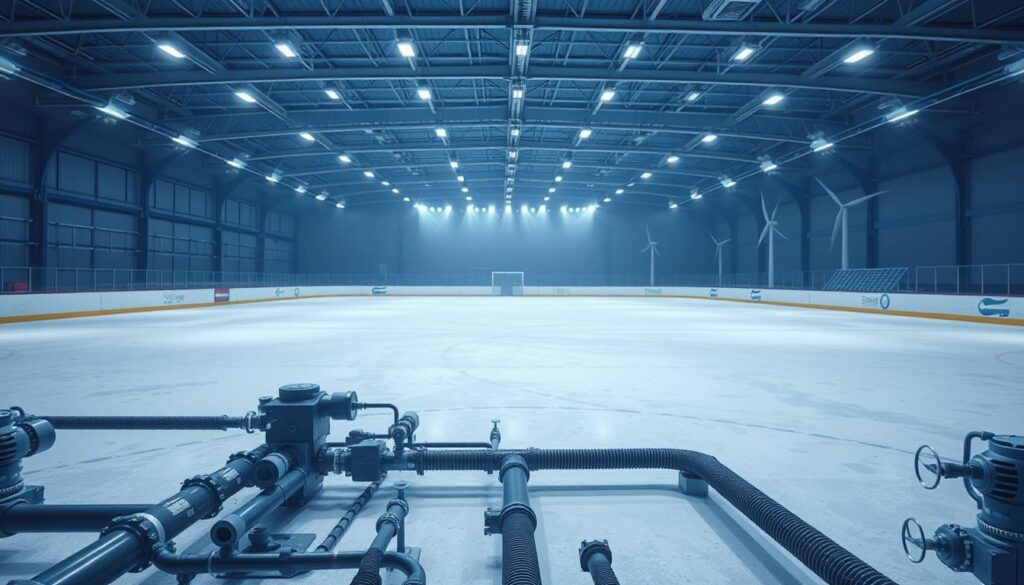
New cooling tech is changing how rinks use energy. These new solutions help keep the ice perfect while being kind to the planet.
Cutting-Edge Cooling Innovations
- CO2 refrigeration systems
- Advanced heat recovery units
- Smart temperature monitoring technologies
- Intelligent energy management platforms
Cost-Saving Strategies
Rink owners can save a lot by managing energy well. Here are some ways to keep the ice right and cut costs:
| Technology | Energy Savings | Implementation Cost |
|---|---|---|
| LED Lighting | 25-40% | Low |
| Enhanced Insulation | 15-30% | Medium |
| Smart Monitoring Systems | 20-35% | High |
Using energy-saving tech is good for the planet and your wallet. It’s a smart move for ice rinks.
Practical Implementation Tips
- Do energy audits often
- Update your cooling gear
- Use real-time temperature checks
- Teach staff to save energy
By using these new ideas, ice rinks can be green and keep the ice perfect. It’s a win-win for everyone.
Safety Considerations Related to Rink Temperature
Skating safety begins with knowing about ice rink temperatures. Keeping the temperature right is key to avoiding accidents. It makes sure everyone can skate safely and smoothly.
Skaters face many safety issues because of ice temperatures. Small changes in temperature can make the ice dangerous. Keeping the temperature steady is important to prevent:
- Soft ice spots that can cause unexpected falls
- Hard, brittle surfaces that increase impact injuries
- Uneven ice textures that disrupt skating performance
Professional ice rinks watch the temperature closely to keep everyone safe. Precision is key – a few degrees can change the ice a lot.
Different skating activities need different temperatures:
- Figure skating: Slightly softer ice for fancy moves
- Hockey: Harder surface for quick turns
- Public skating: Balanced temperature for all skill levels
It’s not just the ice temperature that matters. The air temperature also needs to be right. Rinks must keep the air temperature comfortable to avoid getting too cold. Wearing the right clothes and knowing the weather is important for safe skating.
By understanding and respecting ice rink temperature, skaters can skate safely and confidently.
Common Temperature-Related Issues and Solutions
Ice skating rinks face unique challenges in keeping the ice at the right temperature. Rink managers must always watch and fix temperature problems to ensure great skating conditions.
Knowing the common temperature issues helps skaters and managers work together. This ensures perfect ice conditions for everyone.
Identifying Common Temperature Problems
- Soft or mushy ice surface
- Frost buildup
- Uneven temperature distribution
- Condensation and humidity issues
Troubleshooting Guide
Operators use advanced methods to quickly find and fix temperature problems. This keeps the ice in top shape.
| Issue | Potential Cause | Solution |
|---|---|---|
| Soft Ice | Temperature too warm | Adjust refrigeration system |
| Frost Buildup | High humidity | Dehumidify rink area |
| Uneven Surface | Inconsistent cooling | Recalibrate cooling system |
Preventive Measures
- Regular system calibration
- Consistent temperature monitoring
- Humidity control
- Routine maintenance checks
Skaters can help by telling managers about any ice problems. Prevention is always better than correction when it comes to ice quality.
Professional rinks use the latest technology to keep the ice perfect. This way, managers can ensure a smooth, safe surface for all.
The Role of Humidity in Ice Rink Temperature Management
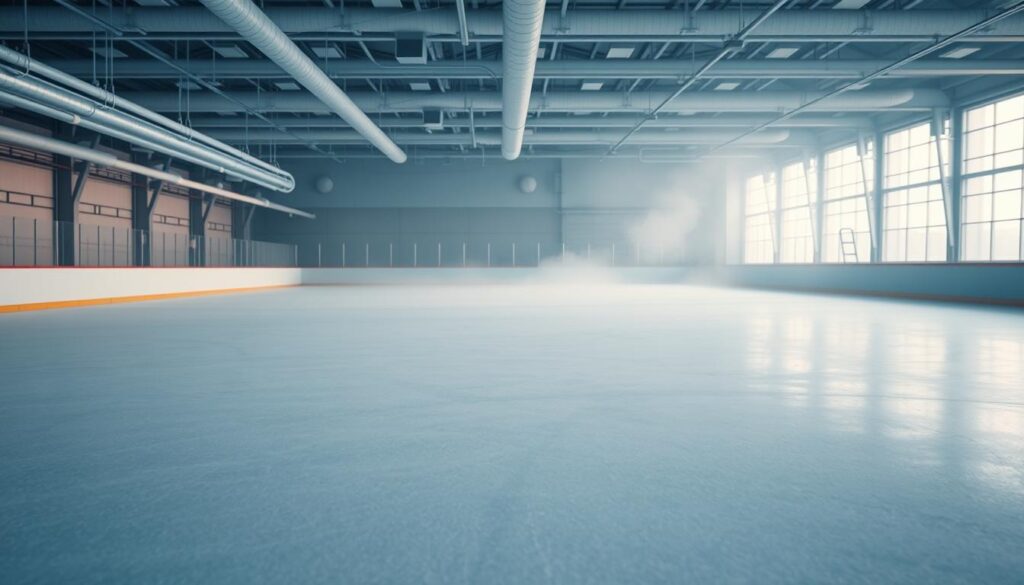
Keeping the ice at the right temperature is more than just watching the thermometer. Humidity is key to perfect skating. Rink managers know that controlling both temperature and moisture is essential.
Too much humidity can ruin the ice. Skaters face problems like fog, condensation, and softer ice. This makes skating harder.
The best humidity for ice is between 35% and 45%. Special climate control systems keep this balance.
| Humidity Level | Ice Condition Impact |
|---|---|
| Below 30% | Ice becomes brittle |
| 35-45% | Optimal skating conditions |
| Above 50% | Surface becomes soft and foggy |
Modern ice rinks use advanced dehumidifiers. Precision air handling units adjust moisture levels constantly. This keeps the ice perfect for all skaters.
Top facilities use the latest in humidity control. By managing these factors, they ensure a great skating experience for everyone.
Temperature Impact on Ice Quality and Maintenance
Ice skating rink temperatures are key to a great skating experience. A smooth, responsive ice sheet is essential. But a rough, challenging surface can ruin the fun.
Keeping the ice at the right temperature is a job that needs skill and precision. Even a small change in temperature can make a big difference. Ice technicians work hard to keep the ice perfect for skating.
- Crystal formation depends on precise temperature control
- Surface hardness directly correlates with temperature stability
- Consistent temperatures reduce maintenance frequency
The science behind ice quality is fascinating. Ideal ice skating rink temperatures are between 24-26 degrees Fahrenheit. At these temperatures, the ice is smooth and perfect for gliding.
Different skating activities need different temperatures. Figure skating needs harder ice, while hockey prefers softer ice. Rinks use advanced cooling systems to get it just right.
Several factors affect ice quality:
- Ambient room temperature
- Humidity levels
- Number of skaters
- Frequency of ice resurfacing
Keeping the ice at the right temperature is both an art and a science. With precision cooling, rinks can offer top-notch skating surfaces.
International Standards for Ice Rink Temperatures
Professional ice skating needs precision at every step. The ice rink temperature is not random. It’s a precise number that ensures athletes perform their best and stay safe.
Ice temperature standards change based on the sport and the organization. Knowing these details helps athletes and rink managers set the perfect temperature for top performance.
Olympic Ice Temperature Protocols
Olympic committees set strict temperature rules for competitions. The ideal ice skating temperature is between 24-26°F (-4 to -3°C). But, the exact temperature can vary by sport:
- Figure Skating: Needs a bit warmer surfaces, around 25°F
- Speed Skating: Prefers colder surfaces, near 22-23°F
- Ice Hockey: Keeps temperatures around 24°F
Professional League Requirements
Professional leagues have their own temperature standards. The National Hockey League (NHL), for example, has strict rules for ice quality and temperature.
| League/Competition | Recommended Temperature | Key Considerations |
|---|---|---|
| NHL | 24-25°F | Fast-paced gameplay dynamics |
| International Figure Skating | 25-26°F | Artistic performance requirements |
| Olympic Speed Skating | 22-23°F | Maximum speed optimization |
These exact temperature standards show how important controlling the environment is in professional skating.
Future Trends in Ice Rink Temperature Control
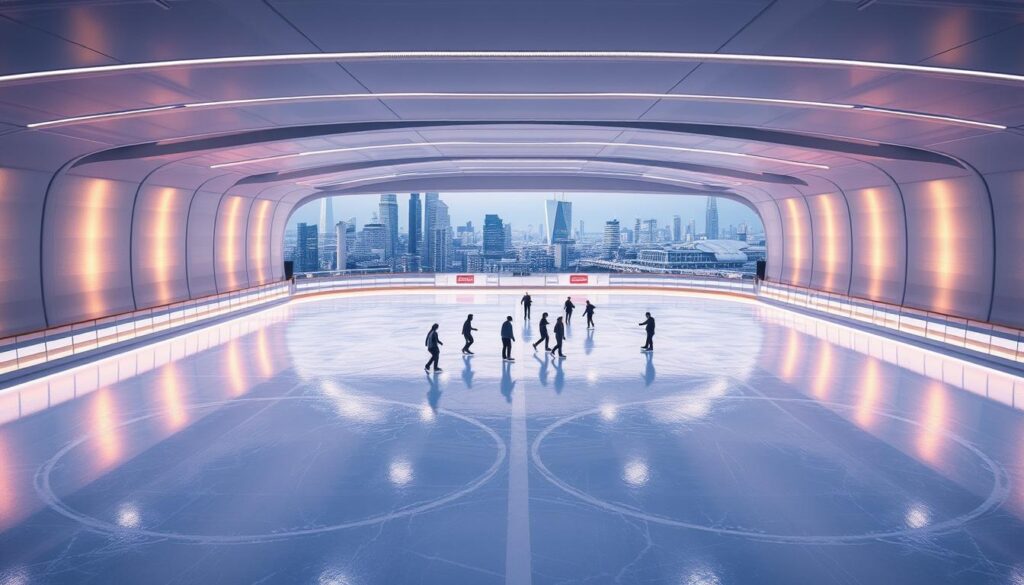
The world of ice skating rink temperatures is changing fast. New technologies are making it easier to keep the ice perfect. This brings new chances for better skating and saving energy.
New ideas are changing how we manage ice rinks. Now, we can watch ice temperatures in real time with great accuracy. These systems can adjust cooling automatically to keep the ice just right.
- AI-powered temperature management systems
- Smart refrigeration technologies
- Energy-efficient cooling solutions
- Predictive maintenance algorithms
Designs for ice rinks are also evolving. New cooling methods are being developed. These methods use less energy but keep the ice perfect.
The future of ice rink temperature control is bright. Quantum sensing and machine learning will offer even better control. This means better skating with less energy used.
Some big advancements include:
- Nanosensor ice temperature tracking
- Adaptive refrigeration systems
- Carbon-neutral cooling technologies
- Real-time environmental compensation mechanisms
Skaters and rink managers have a lot to look forward to. The future of ice rink temperatures will be all about precision and saving energy.
Conclusion
Exploring how cold ice skating rinks are shows us a world of science and tech. The temperature of ice skating rinks is not just a simple number. It’s a mix of engineering, physics, and sports.
Temperature control is key in all skating places, from pro hockey arenas to local rinks. It’s all about the science of keeping the ice just right. This involves cool systems, controlling humidity, and watching the temperature closely.
This knowledge helps both skaters and rink managers. It shows how much work goes into making the ice perfect. Every move on the ice depends on the careful control of the temperature.
As tech gets better, we’ll see even more ways to keep ice rinks cool. The future of skating will be shaped by new systems that help athletes perform at their best.

